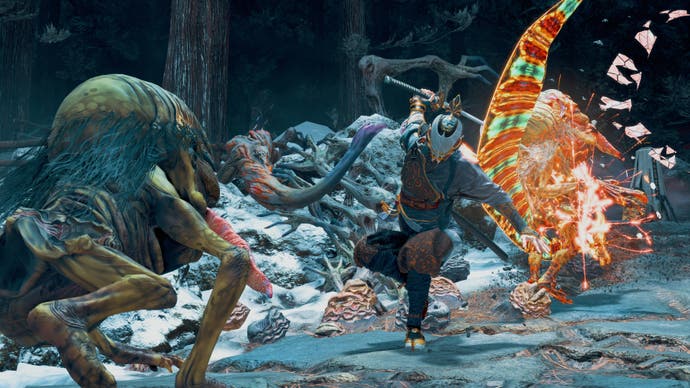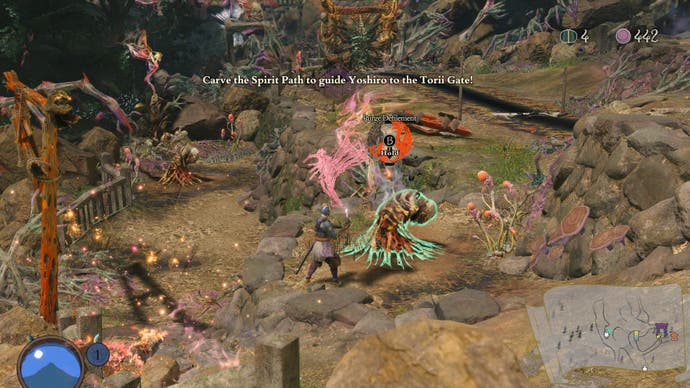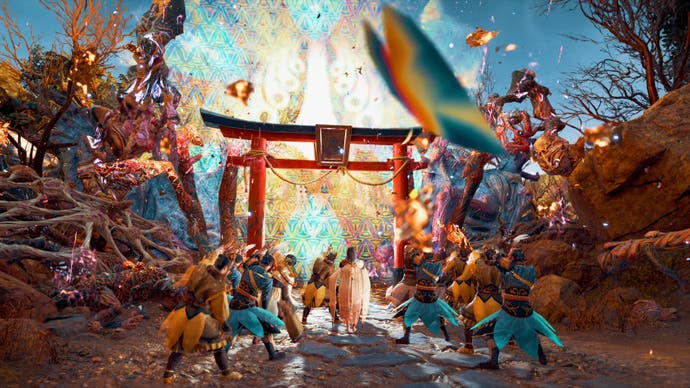Capcom and real-time strategy aren’t words you’d normally associate with each other, but judging from my first five hours with Kunitsu-Gami: Path of the Goddess, this is a match that develops into a truly divine one. This is a strategy game with pure Capcom action at its core, with energetic katana swings and eye-popping button mash-ups, all peppered with some of the most spectacular, kaleidoscopic visual effects this side of Okami (a connection Capcom hasn’t been lost on either, thanks to their free Ammy and Waka costume crossover items releasing at launch).
As Soh’s blade races through the air with his dance-like moveset, he leaves winding trails of color in his wake, as if he’s constantly slicing through alternate dimensions filled with the brightest, most vibrant origami paper you’ve ever seen. It’s a delightful little gift to repeatedly throw yourself into the heat of battle, and it lends each level the kind of action-driven exuberance that you just don’t get from strategy games where your main role is simply directing your units from your skybox high up.
Don’t get me wrong – there’s still a Pikmin-esque layer of organization to Kunitsu-Gami’s midnight battles, as alongside Soh, you’ll also have to free each town’s captured villagers and enlist their help to fend off the nightly waves of Japanese yokai monsters that pour through the town’s countless cursed torii gates. It’s up to you to decide what role (or class) they take and where best to place them, and you can also pause the action at any time if you need to rethink your plan of attack. But it’s this combination of cerebral oversight and physical button mashing that’s absolutely singing about Kunitsu-Gami so far, and I’m eager to see what else it has in store for me as I make my way across this monster-infested mountaintop.
There are dozens of settlements to save on your journey of purification, and each one acts as a traditional level you must complete before moving on to the next. They’re also often surrounded by separate boss battles featuring larger, almost Monster Hunter-sized opponents, which will really test your tactical wits. Your objectives typically come in three flavours – free all the villagers cocooned in cursed, fleshy pods by the rampaging ‘Seethe’ monsters as they rampaged through the mountain, purge the village of all patches of ‘pollution’, and carve a Spirit Path for your priestess Yoshiro to follow so you can lead her to the village’s main torii gate to cleanse it once and for all.
Manage cookie settings
The path itself is laid out in each level, marked by a menacing black stripe on the ground as if an angry streak of calligraphy ink has been run through it. Later levels will occasionally branch this path off in different directions to add an extra layer of tactical thinking to the mix, but initially it functions as a single track on rails that you must manage and defend against the waves of monsters that come during the night. You do, however, gain control over how far or how little Yoshiro moves along it, as carving a path with your sword requires you to spend crystals earned throughout each level, either by purifying the village during the day or defeating its yokai at night. Likewise, from what I’ve played so far, there are no time restrictions to completing levels in a set number of day-night cycles, giving you the freedom to approach each level however you see fit.
For example, sometimes it pays to hold Yoshiro back a bit, even if you have the crystals to push her further toward your goal. A few levels in, you’ll gain access to a carpenter who can help repair nets that can slow enemy advances, as well as buff contraptions that increase the attack power and movement speed of your nearby units. If you let Yoshiro advance too quickly, however, you may not get the most out of these repaired gadgets, as each repair takes time to complete during your limited daylight hours. Likewise, there are special Spirit Ward platforms later in the game that can act as a temporary Seethe shield to slow and thin out their numbers even further, but only if Yoshiro is physically standing on them.


That’s before we even start deciding what units you’re going to deploy, which so far has ranged from melee lumberjacks and tanky sumo wrestlers to long-range archers and movement-binding ascetics. As you’d expect, each has its own strengths and weaknesses to consider, but again, nothing is set in stone here when it comes to adapting. As long as you’ve got the crystals, you can swap out the villager role for something more advantageous if you’re suddenly being attacked from all sides by flying tongue spirits (archers, of all things), or you need to stop the advance of bomb-like belly boys (ascetics, ascetics, ascetics).
There are also thieves, who you can send to dig through the earth during the day for extra treasure, but who’ll run off when the sun goes down, leaving you with a character unless you conveniently spend more crystals to change their role a second time before they run off. And there are other obstacles you can have your villagers clear away, allowing you to reach those last few polluting carcass plants (eat your heart out, The Last of Us), or even a critical final villager pod. More powerful units also cost more crystals, while others can only be taken on by certain villagers – indicated by certain animal stamps on the selection screen.

There’s a lot to juggle in what always feels like a desperately short amount of downtime compared to your nighttime battles (never have I felt the words “daylight saving time” so keenly here). I can’t speak for the later levels yet, but so far the pressure has always felt just right to maintain the tension. My eyes are constantly scanning the densely packed trees and finger-like vines for more places to clear the pollution, and my brain is constantly weighing up what devices I need to repair and how best to defend Yoshiro against multiple lines of attack. Will the Seethe come from this direction, or that? Let’s put my archer here, my sumo there, and maybe I should leave a woodcutter in the back in case they sneak up from behind…
But even if I don’t have all the preparations I want to make by the time the lights go out, there’s a part of me that also can’t wait for those torii gates to burst open and all hell to break loose. When those Seethe appear, it’s 100% time to go, and I relish the moment when I can sprint Soh to the front lines, chasing down the hordes of wagging tongues, bony limbs, sunken eyes, and bulging jawed monsters while my very capable comrades pick up the slack behind me. Sure, there are times when I have to fall back and help them out, especially on larger levels where multiple torii gates are spewing Seethe at once, but for the most part they’re pretty reliable and certainly don’t require the kind of micromanagement that some AI teammates do that in other games I’ve played (I’m looking at you, Ni No Kuni).



There are undoubtedly more efficient ways to take down these ghouls – as evidenced by the plethora of time-attack achievements that entice you to replay the game later in the game for additional upgrade treasures and trinkets to equip – but for now I’m just enjoying the thrill of watching Soh’s sword dance attacks in action (and repeatedly pausing mid-sword swing to get up close with his really, really good photo mode). If Kunitsu-Gami can keep up the pace of this energetic tactical action into the game’s second half, this really could be something quite special – and judging by the slew of as-yet-unlocked village classes I can see on my roll dashboard, I really hope this game has the legs to maintain its thus far-great sense of variety. Each level was a new monster to tackle, a new role to deal with, and a new scenario to rewire my brain with (big shout-out to the level that strips you of Soh entirely to focus on learning how to properly equip your carpenter gear), and I loved every second of it. Here’s hoping for an equally stellar second half.
